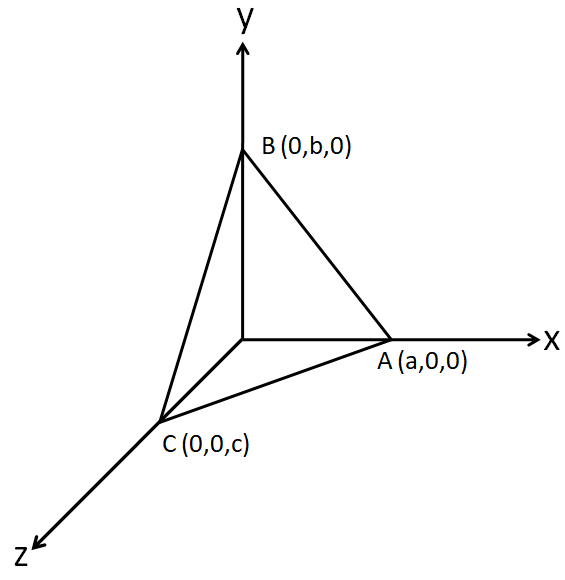Question
Question: A variable plane is at a constant distance p from the origin and meets the axes in A, B and C. The l...
A variable plane is at a constant distance p from the origin and meets the axes in A, B and C. The locus of the centroid of the triangle ABC is
(a) x−2+y−2+z−2=p−2
(b) x−2+y−2+z−2=4p−2
(c) x−2+y−2+z−2=16p−2
(d) x−2+y−2+z−2=9p−2
Solution
We can assume the coordinates of the points A, B and C as (a,0,0), (0,b,0) and (0,0,c). From these coordinates, we can determine the coordinates of the centroid of the triangle ABC as x=3a,y=3b,z=3c. Also, the equation of the plane, from the intercept form can be determine as ax+by+cz=1. From this equation, we can determine the distance of the plane from the origin, which is given to be equal to p, in terms of a, b and c. The values of a, b and c can be substituted in terms of the coordinates of the centroid given as x=3a,y=3b,z=3c to get the final equation of the locus of the centroid.
Complete step by step solution:
Let the coordinates of the points A, B and C be (a,0,0), (0,b,0) and (0,0,c), so that the plane will look like

Therefore, the x coordinate of the triangle ABC becomes
⇒x=3a+0+0⇒x=3a......(i)
Similarly, the y and the z coordinates can be given by
⇒y=3b......(ii)⇒z=3c......(iii)
Multiplying the equation (i) by 3 we get
⇒a=3x......(iv)
Similarly, from the equations (ii) and (iii) we obtain
⇒b=3y.......(v)⇒c=3z.......(vi)
From the intercept form of the equation of a plane, we can write the equation of the given plane as
⇒ax+by+cz=1⇒ax+by+cz−1=0
According to the question, the distance of the plane from the origin is equal to p. Thereofr, we can write
⇒p=(a1)2+(b1)2+(c1)2a0+b0+c0−1⇒p=(a1)2+(b1)2+(c1)21
Taking the reciprocals of both the sides, we get
⇒p1=(a1)2+(b1)2+(c1)2
Now, taking the squares of both the sides, we get
⇒(p1)2=(a1)2+(b1)2+(c1)2⇒p21=a21+b21+c21
Substituting the equations (iv), (v) and (vi) we get
